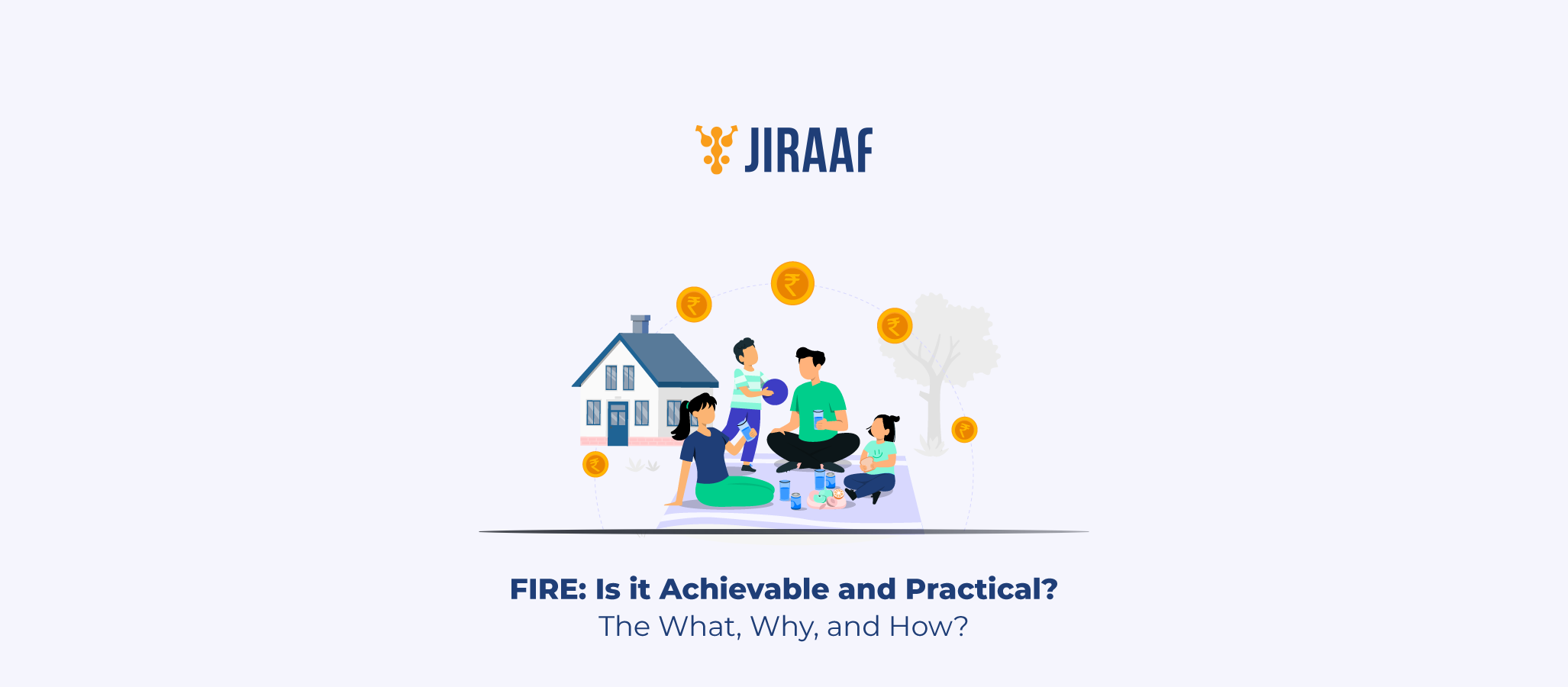For decades, a huge chunk of the middle class lived by one simple formula: get a degree, find a job, work hard, climb the corporate ladder gradually, retire at 65, and then finally enjoy life. But the youngsters today see their lives a little differently.
The 10-to-7 stress, job dissatisfaction, never-ending deadlines, and a relentless cycle of running after promotions doesn’t serve everyone’s goals. They have started to ask what would happen if they flipped the table. What if instead of waiting for decades, they retired early with all the savings they would need?
This dream turned into a movement called ‘financial independence, retire early’, where people started saving and investing aggressively to retire much earlier than the conventional retirement age.
If you also dream about waking up with no morning rush, no office deadlines, no stress, and seek to escape from financial insecurity and traditional career timelines, FIRE might just be worth a try.
But can you retire early without compromising your long-term security or lifestyle? Is FIRE right for you? Let’s answer these and more such questions below.
What is FIRE? The Financial Independence, Retire Early Concept
Before you decide whether FIRE is a suitable strategy for your goals, let’s understand what it is and how it works.
FIRE is a financial strategy that can help you accumulate enough wealth to cover your living expenses for your entire life at an age much lower than 60-65, allowing for early retirement.
This movement gained traction globally in the 1990s with books like ‘Your Money or Your Life’ by Vicki Robin, later evolving into a structured approach emphasizing high savings, strategic investing, and disciplined spending.
In India, FIRE gained popularity much later, in the 2010s, when professionals wanting to avoid burnout, pursue passion projects, or simply gain financial freedom before the traditional retirement age started getting interested.
Digital businesses, remote work, and accessible global investments also lowered the barriers to achieving FIRE, contributing to the growing popularity of the concept.
The Core Principles of FIRE
As a movement, FIRE is based on some core principles, such as:
Increasing Income and Saving Aggressively
- All FIRE followers maintain a higher-than-usual savings rate (typically 50% or more) to achieve their goal. Boosting income through salary negotiations, freelancing, or side businesses also significantly shortens the timeline since savings are only half the course of action; increasing income is the other half.
- Investing Smartly for Long-term Growth
FIRE isn’t just about saving but also increasing your money, and the best way to do that is by investing efficiently. Allocating assets across index funds, bonds, real estate, stocks, and alternative investments ensures your wealth grows faster than inflation.
- Living Frugally and Reducing Expenses
Keeping expenses low helps accelerate your savings. To that end, many FIRE followers avoid lifestyle inflation, optimize recurring costs, and focus on their needs over wants.
- Following the 4% Rule and Safe Withdrawal Rate
Withdrawing 4% of your portfolio annually (adjusted for inflation) post-retirement ensures that your portfolio remains sustainable in the long term. For instance, if your annual expenses are ₹12 lakh, you’d need a corpus of ₹3 crore. You can withdraw ₹4.8 lakhs annually (4% of ₹3 crores) to maintain your standard of living during retirement, while preserving your wealth.
The FIRE Formula: How to Calculate Your FIRE Number?
What is the FIRE number?
Your FIRE number represents the total amount of money you need to save before retiring early. This number varies for different investors based on their lifestyle, risk appetite, and the goal age of retirement, among other things.
Your FIRE number is calculated based on your annual living expenses multiplied by 25 (using the 4% Rule).
So, the formula looks like:
FIRE number = Annual Expenses × 25
For example, if you need ₹15 lakh per year post retirement, your FIRE number would be ₹3.75 crore (without factoring in future inflation).
Remember that factors like inflation, asset allocation, and lifestyle changes can impact the required corpus.
Things to Keep in Mind to Arrive at the Right FIRE Number
- Estimate Post-retirement Expenses: Calculate your annual spending on basic expenses like housing, food, transportation, and lifestyle needs. This forms the base of your FIRE number.
- Adjust for Inflation: The inflation rate (typically 6–7% in India) will increase future expenses. Use inflation-adjusted projections to ensure your savings last through retirement.
- Use the FIRE Formula: Multiply your estimated annual expenses by 25 (for the 4% rule) to determine the corpus needed for early retirement.
- Include Additional Costs: Keep in mind the rising medical expenses, insurance premiums, etc. while setting your FIRE goal, as these costs increase significantly with age and may surpass the 6-7% inflation rate, so your income should be able to cover for them.
FIRE Strategies and Methods
FIRE followers observe these four variations or methods to arrive at financial independence early.
Lean FIRE: Retiring Early with Minimal Expenses
This method focuses on extreme frugality and minimal living costs while you try to achieve financial independence, with a smaller corpus as compared to FAT, COAST, or BARISTA FIRE strategies. It requires disciplined spending and a minimalist lifestyle to ensure the long-term sustainability of your portfolio.
Fat FIRE: Retiring Early with A Higher Standard of Living
This approach allows for a more comfortable or luxurious lifestyle post-retirement. It requires a significantly larger corpus, for which people need higher earnings, aggressive savings, and well-diversified investments.
Barista FIRE: Working Part-Time While Enjoying Financial Independence
This strategy involves reaching partial financial independence, wherein investments cover most of the expenses, and individuals continue working part-time in low-stress jobs to supplement their income and access benefits like health insurance. This does not follow a set timeline but depends on your savings, investments, and overall goals. When your corpus takes care of most of your basic expenses, you can retire and work to earn only the extra income you need.
Coast FIRE: Reaching A Point Where Investments Grow Without Extra Savings
This method requires aggressive early investments, allowing individuals to stop saving and shift to lower-stress jobs while their portfolio grows passively through compounding.
Pros and Challenges of the FIRE Movement
| Sr. No. | Pros of FIRE | Challenges of FIRE |
| 1 | It provides independence from employment and reduces reliance on a paycheck. | Economic downturns or poor investment performance can deplete savings faster than expected. |
| 2 | Allows you the freedom to pursue passion projects, entrepreneurship, or part-time work without financial pressure. | India’s inflation (typically 6–7%) can erode purchasing power, requiring higher corpus estimates. |
| 3 | It eliminates job-related burnout and financial uncertainty, leading to a more relaxed lifestyle. | Rising medical expenses and limited public healthcare support necessitate robust health insurance and contingency planning, which makes following FIRE more difficult. |
| 4 | Enables extensive travel, personal development, and more time with family. | Lack of structured work may lead to boredom, loss of purpose, and social isolation. |
| 5 | Geographic freedom allows you to relocate to lower-cost cities while maintaining a comfortable lifestyle. | Retiring early means managing money for 40+ years, which requires strong financial discipline and planning. |
The Role of Passive Income in Achieving FIRE Goals
Relying solely on a salary can slow down your FIRE journey, especially when inflation, rising living costs, and financial responsibilities like family obligations can erode your savings.
A side hustle increases your chances of retiring early and comfortably, since you can increase your savings by diversifying your income sources.
Freelancing
IT professionals, digital marketers, writers, and designers can earn ₹50,000–₹3 lakh per month through Upwork, Fiverr, Freelancer, etc. By exploring freelancing opportunities outside of routine work.
Blogging & Content Creation
Running a niche blog on personal finance, travel, or technology can generate income through ads, sponsorships, and affiliate marketing. YouTube and Instagram offer monetization for those who consistently create high-value content.
Online Tutoring and Course Creation
Platforms like Unacademy, Vedantu, and Chegg offer online teaching opportunities. Educators can create courses on Udemy, Skillshare, or Teachable, generating passive income over time.
Dropshipping & E-commerce
Entrepreneurs can sell products globally without maintaining any inventory through platforms like Shopify, WooCommerce, and Amazon FBA with dropshipping. Sellers can use e-commerce platforms to build or grow their businesses for an easy way to earn passive income.
Monetizing Skills Like Cooking, Art, or Crafting
For those with creative or specialized skills, monetizing those hobbies can provide an additional revenue stream.
- Cooking & Baking: Selling homemade food through Instagram, Swiggy, or local sellers.
- Handmade Crafts & Art: Selling on Etsy India, Amazon Karigar, and regional exhibitions.
- Fitness & Yoga Training: Becoming a certified instructor and offering online or in-person sessions.
- Music & Dance Lessons: Teaching via Zoom, YouTube, social media memberships, or in-person sessions.
Real Estate as a Side Income Source
Investing in real estate now can help you earn passive income in many ways, like:
- Rental Income: Owning residential or commercial properties in tier-2 and tier-3 cities ensures steady cash flow.
- Co-living or Paying Guest (PG) Businesses: A growing market in student and working professional housing, which can help generate steady income.
- Short-term Rentals (Airbnb): Renting out spare rooms or properties for shorter periods earns higher returns overall.
Investing in Alternative Assets
Alternative assets provide diversification and passive income to a portfolio. You can:
- Invest in government securities and corporate bonds as they provide a nuanced balance to a risk-averse portfolio, and are credible sources of passive income through regular payments.
- Invest in REITs (Real Estate Investment Trusts) for property-linked income without managing rentals.
- Buy dividend-paying stocks to build a steady income stream.
- Lend through P2P platforms like Lendbox and Faircent for fixed returns.
- Explore invoice discounting. It can help you generate higher returns in shorter periods with lesser risk.
Indians Who Retired Early Using FIRE: Case Studies
The Minimalist Couple from Bengaluru
This young couple when they were in their 30s used the FIRE strategy and transformed their financial future. They adopted a minimalist lifestyle, cut back on unnecessary expenses, and prioritized savings. They also invested in a mix of index funds, mutual funds, and real estate, and achieved FIRE in their early 40s.
Now, they travel the world, exploring different cultures and sharing their experiences through a popular blog.
The Early Retiree from Chennai
A former IT professional from Chennai was disappointed with the corporate grind and sought a life filled with purpose. He diligently saved and invested a significant portion of his income in the stock market, real estate and bonds. He retired in his late 40s. Now, he dedicates his time volunteering for causes close to his heart while enjoying quality moments with family.
Siddhant and Anjali from Bangalore
Siddhant and Anjali laid the groundwork for an early retirement strategy in their late twenties while working in IT. They adopted elements of the FIRE philosophy by cutting down on mindless spending and focusing on intelligent budgeting. After comfortably retiring, they now run an eco-friendly homestay near Kanha National Park.
How to Implement the FIRE Strategy Effectively?
Here are some tips to help you implement the FIRE principles.
- Define clear financial goals based on your desired lifestyle.
- Create a budget that tracks spending habits.
- Save aggressively—aim to save at least 50% of your income.
- Invest strategically across diverse asset classes.
- Monitor progress regularly and adjust plans as needed.
- Use budgeting apps for tracking your expenses.
- Cook meals at home instead of ordering food frequently.
- Use public transport or carpooling instead of owning multiple vehicles.
- Negotiate better rates on bills like insurance premiums or internet services.
- Automate investments, optimize taxes, and avoid unnecessary spending to increase your savings.
- Balance equity, fixed-income, and alternative assets in your diversified portfolio.
- Use spreadsheets, FIRE calculators, and investment tracking apps to monitor your progress regularly.
What is the Ideal Age to Retire Early?
Even though most people try to build a corpus between their late thirties and early fifties, there is no ideal age to retire early. It depends on your goals after retirement, efficiently saving, investing, managing expenses, and your strategy, among other factors.
Your responsibilities, healthcare needs, financial goals, etc., also affect your FIRE timeline.
Remember, there is no ideal age, so choose a comfortable age range to retire that is achievable.
Final Words
FIRE challenges traditional Indian views on work and retirement, in stark contrast with developed countries. In the West, retirees rely on state pensions, universal healthcare, and stable social security systems. In India, people must plan around healthcare costs, familial responsibilities, and the absence of government-backed retirement support.
However, India provides investors with some unique and essential advantages. Equity markets offer strong long-term growth, and tax-efficient instruments like PPF and NPS provide steady, compounding returns. Even conservative options like RBI Floating Rate Bonds offer inflation-linked income, something many developed markets don’t offer as reliably.
While achieving full FIRE may be unrealistic for some, hybrid strategies like Coast or Barista FIRE offer investors a more achievable and sustainable path. These approaches don’t focus on quitting work entirely but on gaining the flexibility to choose how and when to work. By investing smartly, controlling expenses, and building solid buffers for healthcare and family needs, you can achieve financial independence on your own terms.
Frequently Asked Questions
What is FIRE full form in Finance?
FIRE stands for “Financial Independence, Retire Early”. It’s all about saving and investing wisely so you can ditch the 9-to-5 grind earlier than the traditional age and enjoy life on your own terms. The idea is to live frugally, build up your savings, and have enough money to cover your expenses without relying on a job as your primary income source.
What Is the 4% Rule for Early Retirement?
The 4% rule is a popular guideline for people who want to retire early. It suggests that you can safely withdraw 4% of your savings each year after you retire, without running out of money too soon. So, this rule helps you figure out how much you can spend out of your nest egg each year while still keeping your finances healthy for the long haul.
How to Calculate FIRE Number?
To calculate your FIRE number, first figure out how much you’ll need each year in retirement. Then, just multiply that number by 25 (based on the 4% rule). For example, if you think you’ll need ₹6 lakh a year, your FIRE number would be ₹1.5 crore (₹6 lakh x 25). This gives you a target to aim for, so you can kick back and enjoy life when the time comes.
What is FIRE Age?
FIRE age is simply the age at which you can retire early after achieving financial independence. While most people think of retiring around 65, those chasing FIRE often aim for their 30s or 40s. Your specific FIRE age depends on how much you save and invest along the way. It’s all about planning ahead so you can enjoy life sooner rather than later.
What is the 7% Rule in FIRE Method?
The 7% Rule is another approach some people use for retirement withdrawals. It suggests that you can take out up to 7% of your savings from your retirement corpus each year. While this gives you more cash to spend upfront compared to the 4% rule, it’s a bit riskier since it could deplete your funds faster, especially if your passive income sources take a hit.
Discover fixed income investments with Jiraaf, a SEBI registered online bonds platform that educates and brings access to a wide array of bonds. Sign up today to explore diversified fixed income investment opportunities to support your goal-based wealth creation journey. Start investing!



